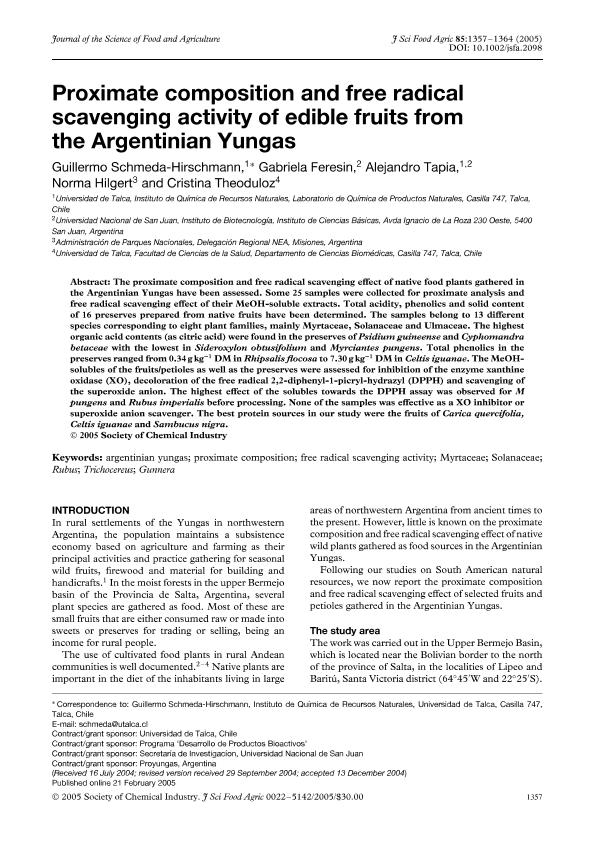Artículo
Proximate composition and free radical scavenging activity of edible fruits from the Argentinian Yungas
Schmeda Hirschmann, Guillermo; Feresin, Gabriela Egly ; Tapia, Aníbal Alejandro; Hilgert, Norma Ines
; Tapia, Aníbal Alejandro; Hilgert, Norma Ines ; Theoduloz, Cristina
; Theoduloz, Cristina
 ; Tapia, Aníbal Alejandro; Hilgert, Norma Ines
; Tapia, Aníbal Alejandro; Hilgert, Norma Ines ; Theoduloz, Cristina
; Theoduloz, Cristina
Fecha de publicación:
02/2005
Editorial:
John Wiley & Sons Ltd
Revista:
Journal of the Science of Food and Agriculture
ISSN:
0022-5142
e-ISSN:
1097-0010
Idioma:
Inglés
Tipo de recurso:
Artículo publicado
Clasificación temática:
Resumen
The proximate composition and free radical scavenging effect of native food plants gathered in the Argentinian Yungas have been assessed. Some 25 samples were collected for proximate analysis and free radical scavenging effect of their MeOH‐soluble extracts. Total acidity, phenolics and solid content of 16 preserves prepared from native fruits have been determined. The samples belong to 13 different species corresponding to eight plant families, mainly Myrtaceae, Solanaceae and Ulmaceae. The highest organic acid contents (as citric acid) were found in the preserves of Psidium guineense and Cyphomandra betaceae with the lowest in Sideroxylon obtusifolium and Myrciantes pungens. Total phenolics in the preserves ranged from 0.34 g kg−1 DM in Rhipsalis flocosa to 7.30 g kg−1 DM in Celtis iguanae. The MeOH‐solubles of the fruits/petioles as well as the preserves were assessed for inhibition of the enzyme xanthine oxidase (XO), decoloration of the free radical 2,2‐diphenyl‐1‐picryl‐hydrazyl (DPPH) and scavenging of the superoxide anion. The highest effect of the solubles towards the DPPH assay was observed for M pungens and Rubus imperialis before processing. None of the samples was effective as a XO inhibitor or superoxide anion scavenger. The best protein sources in our study were the fruits of Carica quercifolia, Celtis iguanae and Sambucus nigra.
Archivos asociados
Licencia
Identificadores
Colecciones
Articulos(CCT - NORDESTE)
Articulos de CTRO.CIENTIFICO TECNOL.CONICET - NORDESTE
Articulos de CTRO.CIENTIFICO TECNOL.CONICET - NORDESTE
Citación
Schmeda Hirschmann, Guillermo; Feresin, Gabriela Egly; Tapia, Aníbal Alejandro; Hilgert, Norma Ines; Theoduloz, Cristina; Proximate composition and free radical scavenging activity of edible fruits from the Argentinian Yungas; John Wiley & Sons Ltd; Journal of the Science of Food and Agriculture; 85; 8; 2-2005; 1357-1364
Compartir
Altmétricas



